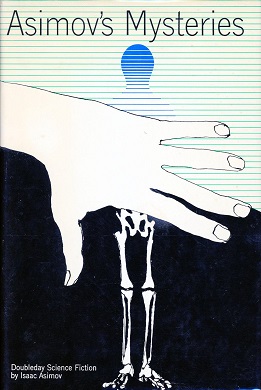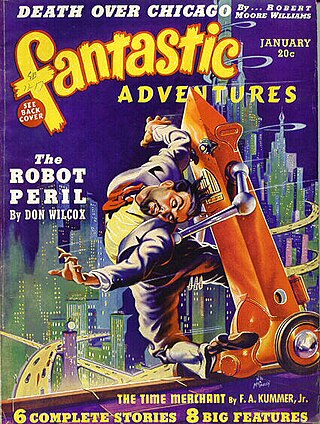
Isaac Asimov was an American writer and professor of biochemistry at Boston University. During his lifetime, Asimov was considered one of the "Big Three" science fiction writers, along with Robert A. Heinlein and Arthur C. Clarke. A prolific writer, he wrote or edited more than 500 books. He also wrote an estimated 90,000 letters and postcards. Best known for his hard science fiction, Asimov also wrote mysteries and fantasy, as well as popular science and other non-fiction.

The Satyricon, Satyriconliber, or Satyrica, is a Latin work of fiction believed to have been written by Gaius Petronius in the late 1st century AD, though the manuscript tradition identifies the author as Titus Petronius. The Satyricon is an example of Menippean satire, which is different from the formal verse satire of Juvenal or Horace. The work contains a mixture of prose and verse ; serious and comic elements; and erotic and decadent passages. As with The Golden Ass by Apuleius, classical scholars often describe it as a Roman novel, without necessarily implying continuity with the modern literary form.

"The Last Question" is a science fiction short story by American writer Isaac Asimov. It first appeared in the November 1956 issue of Science Fiction Quarterly and in the anthologies in the collections Nine Tomorrows (1959), The Best of Isaac Asimov (1973), Robot Dreams (1986), The Best Science Fiction of Isaac Asimov (1986), the retrospective Opus 100 (1969), and in Isaac Asimov: The Complete Stories, Vol. 1 (1990). While he also considered it one of his best works, "The Last Question" was Asimov's favorite short story of his own authorship, and is one of a loosely connected series of stories concerning a fictional computer called Multivac. Through successive generations, humanity questions Multivac on the subject of entropy.

The Best of Isaac Asimov is a collection of twelve science fiction short stories by American writer Isaac Asimov, published by Sphere in 1973. It begins with a short introduction giving various details on the stories, such as how they came to be written, or what significance merits their inclusion in a "best of" collection, as well as some of Dr. Asimov's thoughts on a best of collection itself. The stories included are two of his early works, two of his late works (post-1960), and eight from the 1950s, which he refers to as his "golden decade" in the introduction. Except for the last story in the book, "Mirror Image", none of the stories are related to his Robot and Foundation series, while a few mention the Multivac computer.
Multivac is the name of a fictional supercomputer appearing in over a dozen science fiction stories by American writer Isaac Asimov. Asimov's depiction of Multivac, a mainframe computer accessible by terminal, originally by specialists using machine code and later by any user, and used for directing the global economy and humanity's development, has been seen as the defining conceptualization of the genre of computers for the period (1950s–1960s). Multivac has been described as the direct ancestor of HAL 9000.

Nightfall and Other Stories (1969) is a collection of 20 previously published science fiction short stories by Isaac Asimov. Asimov added a brief introduction to each story, explaining some aspect of the story's history and/or how it came to be written.

"Anniversary" is a science fiction short story by American writer Isaac Asimov. It was first published in the March 1959 issue of Amazing Stories and subsequently appeared in the collections Asimov's Mysteries (1968) and The Best of Isaac Asimov (1973).

Buy Jupiter and Other Stories is a 1975 collection of short stories by American writer Isaac Asimov. Each story is introduced by a short account of how it came to be written and what was happening in Asimov's life at the time, and follows on from where The Early Asimov (1972) left off. In the introduction, Asimov explains that his objective is to tell enough of his autobiography in his short story collections so that his editors will stop asking him to write an actual autobiography.

Asimov's Mysteries, published in 1968, is a collection of 14 short stories by American writer Isaac Asimov, almost all of them science fiction mysteries. The stories were all originally published in magazines between 1954 and 1967, except for "Marooned off Vesta", Asimov's first published story, which first appeared in 1939.

"Franchise" is a science fiction short story by American writer Isaac Asimov. It first appeared in the August 1955 issue of the magazine If: Worlds of Science Fiction, and was reprinted in the collections Earth Is Room Enough (1957) and Robot Dreams (1986). It is one of a loosely connected series of stories concerning a fictional computer called Multivac. It is the first story in which Asimov dealt with computers as computers and not as immobile robots.
"Question" is a science fiction short story by American writer Isaac Asimov. The story first appeared in the March 1955 issue of Computers and Automation, and was reprinted in the April 30, 1957, issue of Science World. It is the first of a loosely connected series of stories concerning a fictional supercomputer called Multivac.
"Jokester" is a science fiction short story by American writer Isaac Asimov. It first appeared in the December 1956 issue of Infinity Science Fiction, and was reprinted in the collections Earth Is Room Enough (1957) and Robot Dreams (1986). It is one of a loosely connected series of stories concerning a fictional computer called Multivac.
"The Machine That Won the War" is a science fiction short story by American writer Isaac Asimov. The story first appeared in the October 1961 issue of The Magazine of Fantasy & Science Fiction, and was reprinted in the collections Nightfall and Other Stories (1969) and Robot Dreams (1986). It was also printed in a contemporary edition of Reader's Digest, illustrated. It is one of a loosely connected series of such stories concerning a fictional supercomputer called Multivac.
"The Life and Times of Multivac" is a science fiction short story by American writer Isaac Asimov. The story first appeared in the 5 January 1975 issue of The New York Times Magazine, and was reprinted in the collections The Bicentennial Man and Other Stories and The Best of Creative Computing in 1976. It is one of a loosely connected series of stories concerning a fictional supercomputer called Multivac. "The Life and Times of Multivac" was the first piece of fiction ever commissioned and published by The New York Times.
"Point of View" is a short story by American writer Isaac Asimov that first appeared in Boys' Life magazine in July 1975. Due to the poor reception it received, it was only reprinted in the collection The Complete Robot in 1982. It is one of a loosely connected series of such stories concerning a fictional computer called Multivac.
"My Son, the Physicist" is a science fiction short story by American writer Isaac Asimov. It was commissioned by Hoffman Electronics Corporation and appeared in February 1962 in Scientific American. It later appeared in Asimov's collection Nightfall and Other Stories (1969).

The Cumaean Sibyl was the priestess presiding over the Apollonian oracle at Cumae, a Greek colony near Naples, Italy. The word sibyl comes from the ancient Greek word sibylla, meaning prophetess. There were many sibyls throughout the ancient world. Because of the importance of the Cumaean Sibyl in the legends of early Rome as codified in Virgil's Aeneid VI, and because of her proximity to Rome, the Cumaean Sibyl became the most famous among the Romans. The Erythraean Sibyl from modern-day Turkey was famed among Greeks, as was the oldest Hellenic oracle, the Sibyl of Dodona, dating to the second millennium BC according to Herodotus, favored in the east.

Super-Science Fiction was an American digest science fiction magazine published from 1956 to 1959, edited by W. W. Scott and published by Feature Publications. Robert Silverberg and Harlan Ellison, who were at the start of their careers at the time, were already selling crime stories to Scott for his other magazines, Trapped and Guilty, and quickly started bringing Scott science fiction stories as well. Scott bought scores of stories from the pair during the magazine's short life; much of the remainder was sent in by literary agents, and generally comprised material rejected by other magazines first, though Scott did obtain two stories from Isaac Asimov.

AI takeover—the idea that some kind of artificial intelligence may supplant humankind as the dominant intelligent species on the planet—is a common theme in science fiction. Famous cultural touchstones include Terminator and The Matrix.
Depending on the counting convention used, and including all titles, charts, and edited collections, there may be currently over 500 books in Isaac Asimov's bibliography—as well as his individual short stories, individual essays, and criticism. For his 100th, 200th, and 300th books, Asimov published Opus 100 (1969), Opus 200 (1979), and Opus 300 (1984), celebrating his writing.










